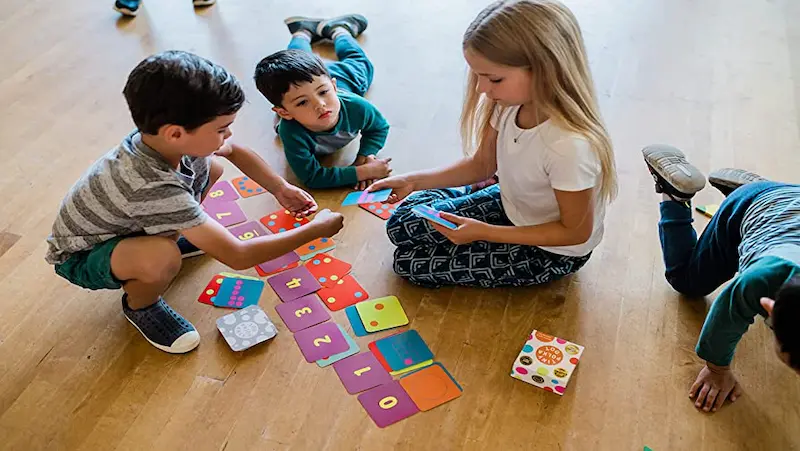What if you could turn your living room into a magical wonderland of fun and laughter for your kids? Indoor activities for kids can be a fantastic way to keep your little ones engaged and entertained, especially during those rainy days or long winter evenings. So, get ready to embark on a journey of creativity and excitement!
One of the most enjoyable indoor activities for kids is building forts using blankets, cushions, and chairs. Let their imaginations run wild as they create secret hideouts or cozy reading nooks. Another great option is setting up an indoor treasure hunt, where you can hide clues around the house leading to a special surprise at the end. This will keep them entertained and encourage problem-solving skills.
If your children love arts and crafts, why not organize a mini-art exhibition in your own home? Set up an art station with paints, brushes, and paper, and let them unleash their inner Picasso. You can even invite family members to be esteemed art critics.
For the little adventurers, transform your living room into a mini obstacle course. Use pillows for stepping stones, set up tunnels made from blankets, and create a “lava” floor with cushions to jump over. This activity will not only keep them active but also enhance their balance and coordination.
Indoor activities for kids are not just about keeping them busy; they also provide opportunities for learning, bonding, and creativity. So, let the fun begin and watch your living room transform into a world of endless possibilities!
Table of contents
Introduction
Indoor activities for kids play a crucial role in their overall development and well-being. While outdoor play is important, indoor activities offer unique benefits that shouldn’t be overlooked.
First and foremost, indoor activities provide a safe and controlled environment for children to engage in play. This is especially valuable during inclement weather or in situations where outdoor play is not feasible. By engaging in stimulating indoor activities, kids can channel their energy, stay active, and avoid boredom.
Moreover, indoor activities foster creativity and imagination. Whether it’s building forts, creating artwork, or engaging in pretend play, these activities encourage children to think outside the box, problem-solve, and express themselves in unique ways. They can unleash their imagination, develop storytelling skills, and explore new ideas.
Indoor activities also promote cognitive development. Many activities involve puzzles, free games for kids, or challenges that stimulate critical thinking, problem-solving, and decision-making skills. Additionally, activities that involve reading, writing, or crafts contribute to literacy and fine motor skill development.
Furthermore, indoor activities provide opportunities for social interaction and bonding. Children can engage in cooperative play, take turns, negotiate, and learn important social skills such as communication and teamwork. This helps build relationships, develop empathy, and enhance their emotional intelligence.
In all, indoor activities for kids offer a host of benefits ranging from physical exercise and cognitive development to fostering creativity and social skills. By incorporating these activities into their routine, parents can provide a well-rounded and enriching environment for their children’s growth and development.

BrightChamps offers a diverse collection of free computer games for kids, providing indoor activities that are not only enjoyable but also promote learning and useful communication skills.
Age-Appropriate Indoor Activities
Indoor activities can be tailored to different age groups, ensuring that each child’s needs and interests are met. Here are some engaging activities suitable for toddlers, preschoolers, and school-age children:
I. Toddlers (Ages 1-3)
a. Sensory Play: Set up a sensory bin with materials like colored rice, water beads, or soft fabric. Let them explore different textures and engage their senses.
b. Shape Sorting: Provide simple shape-sorting toys or puzzles to help toddlers develop their cognitive skills and hand-eye coordination.
c. Dance Party: Play upbeat music and encourage toddlers to dance, jump, and move their bodies, promoting gross motor skills and self-expression.
d. Bubble Play: Blow bubbles and watch toddlers chase and pop them, enhancing their visual tracking and fine motor skills.
e. DIY Sensory Bottles: Create sensory bottles using water, glitter, beads, or other small objects. These mesmerizing bottles provide sensory stimulation and calming effects.

II. Preschoolers (Ages 3-5)
a. Arts and Crafts: Engage preschoolers in age-appropriate art projects using finger painting, coloring, or collage-making to encourage creativity and fine motor skills.
b. Science Experiments: Conduct simple science experiments like making volcanoes with baking soda and vinegar or creating homemade slime to foster curiosity and hands-on learning.
c. Indoor Camping: Set up a mini camping adventure by building forts or indoor tents using blankets and pillows. Add camping-themed books and pretend-play camping accessories for added fun.
d. Treasure Hunt: Organize an indoor scavenger hunt with clues leading to hidden treasures, encouraging problem-solving and critical thinking skills.
e. Storytelling and Reading: Read aloud engaging stories or encourage preschoolers to create their own stories using picture cards or puppets, stimulating their imagination and language development.

III. School-Age Children (Ages 6-12)
a. Board Games and Puzzles: Engage school-age children in challenging board games, jigsaw puzzles, or strategy games that promote problem-solving, critical thinking, and social skills.
b. Cooking and Baking: Involve children in age-appropriate cooking or baking activities, allowing them to follow recipes, measure ingredients, and learn kitchen safety.
c. DIY Science Projects: Conduct science experiments like creating a homemade volcano, building a simple circuit, or growing plants from seeds, fostering scientific inquiry and understanding.
d. Yoga or Exercise Routines: Teach school-age children simple yoga poses or guide them through exercise routines designed for kids to promote physical fitness, flexibility, and mindfulness.
e. Building Challenges: Encourage children to construct structures using building blocks, LEGO, or other building kits, promoting spatial awareness, creativity, and problem-solving skills.
By tailoring indoor activities to different age groups, you can provide an enriching and developmentally appropriate environment for your children, keeping them engaged, entertained, and continuously learning.

Tips for Successful Indoor Playtime
To ensure a fun and engaging indoor playtime experience for your kids, here are some tips and suggestions:
a. Create a designated play area: Set aside a specific area in your home for playtime, equipped with toys, art supplies, and other materials. This helps create a focused play environment and keeps the rest of the house organized.
b. Set a routine or schedule: Establish a consistent daily or weekly schedule for indoor playtime. This provides structure and helps children know what to expect. Include a mix of activities, such as creative play, educational games for kids, and physical exercise.
c. Involve kids in activity planning: Allow your children to have a say in choosing the activities they want to engage in. This gives them a sense of ownership and increases their motivation and enthusiasm for playtime.
d. Use technology wisely: While it’s important to limit screen time, technology can also be used as a tool for educational and interactive activities. Look for age-appropriate apps, websites, or educational videos that provide engaging content aligned with their interests and learning goals.
e. Balance structured and unstructured playtime: While structured activities have their benefits, don’t forget to leave room for unstructured play where children can freely explore and use their imagination. Encourage open-ended play, allowing them to create their own games, stories, or art projects.

Additional Resources
a. Website: The Artful Parent provides a wide range of art and craft ideas for kids of all ages, including easy-to-follow tutorials and creative inspiration.
b. Book: “101 Kids Activities That Are the Bestest, Funnest Ever!” by Holly Homer and Rachel Miller – Offers a collection of simple, engaging, and fun activities for children, covering a variety of interests and age ranges.
c. App: Sago Mini World – An interactive and educational app with a collection of mini-games, puzzles, and creative activities designed for toddlers and preschoolers.
d. Article: “20 Indoor fun Activities for Kids: Ideas to Keep Them Busy” by VeryWell Family provides a list of indoor activity ideas with detailed instructions and tips for each activity.
Remember, indoor playtime should be a time for fun, learning, and bonding. By incorporating these tips and exploring additional resources, you can create a vibrant and enjoyable indoor play environment for your children.
Conclusion
In conclusion, indoor activities for kids offer a multitude of benefits, regardless of their age group. By providing a safe and controlled environment, parents can foster creativity, stimulate cognitive development, promote social interaction, and keep their children engaged and entertained.
Creating a designated play area, setting a routine, involving kids in activity planning, using technology wisely, and balancing structured and unstructured playtime are effective strategies for ensuring a fun and engaging indoor play experience.
To get your hands on more such educational and free resources on coding for kids, robotics courses for kids, game development, etc., do check out the Brightchamps Page now!
Frequently Asked Questions
Engaging indoor activities for kids include building forts, arts and crafts projects, indoor scavenger hunts, storytelling, board games, cooking activities, and DIY science experiments.
You can keep your kids entertained indoors by organizing indoor scavenger hunts, setting up art and craft activities, playing board games, engaging in imaginative play, and trying out science experiments or cooking projects together.
Yes, there are numerous educational games suitable for indoor play. Examples include math and language learning games, puzzle games, trivia games, and STEM-based games that promote critical thinking and problem-solving skills.
Some easy arts and crafts projects for children include paper plate masks, handprint animals, DIY slime, paper bag puppets, painted rocks, or making simple collages with cut-out shapes and materials.
For toddlers: Sensory bins, shape sorting, dancing to music.
For preschoolers: Storytelling, simple science experiments, building forts.
For school-age children: Board games, cooking/baking, DIY science projects, scavenger hunts, and building challenges.
To plan a successful indoor playtime, create a designated play area, establish a routine, involve your kids in activity planning, balance structured and unstructured play, and provide a variety of engaging activities.
Yes, there are plenty of DIY projects and experiments for kids to try at home, such as making a volcano, creating a homemade slime, building a simple circuit, or growing plants from seeds.


 We are an army of educators and passionate learners from BrightChamps family, committed to providing free learning resources to kids, parents & students.
We are an army of educators and passionate learners from BrightChamps family, committed to providing free learning resources to kids, parents & students.












